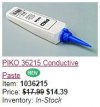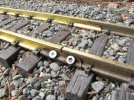DVS4G
RR Dave
Nice page Greg, once again. Thanks (again). If you were a science fiction fan, I'd ask you if your last name was Long. Do you have a time machine? Where do you find the time to do all this figuring, web page creation, and forum posting? I'm assuming it comes from a couple years of obsession with this G scale animal.
So, I'll throw out another topic that sort of relates to track here. Wheels. What do you all favor. Most of the wheels I'm encountering are cheap looking plastic wheels that I assume could be improved. I don't know who has replaced, not replaced, stolen off of other equipment, etc. for these cars. What does LGB come with stock? Are metal wheels better for G as in the other scales I have worked in? Rolling stock I am encountering seems to be LGB and Aristocraft but, for a newbie like me, it isn't always easy to tell. Replace just the wheels or the whole truck? Gregs page also alluded to the fact that wheel flange depth is an important factor for frogs not derailing wheels.
Obviously, if the flange is deeper than 3mm, wheels will bump bump through an LGB frog that is only 3mm deep if that frog is designed to support the flange and keep the tread at rail height. Are other brands frogs fairly close or is it crazy wide variations between brands?
So, I'll throw out another topic that sort of relates to track here. Wheels. What do you all favor. Most of the wheels I'm encountering are cheap looking plastic wheels that I assume could be improved. I don't know who has replaced, not replaced, stolen off of other equipment, etc. for these cars. What does LGB come with stock? Are metal wheels better for G as in the other scales I have worked in? Rolling stock I am encountering seems to be LGB and Aristocraft but, for a newbie like me, it isn't always easy to tell. Replace just the wheels or the whole truck? Gregs page also alluded to the fact that wheel flange depth is an important factor for frogs not derailing wheels.
Obviously, if the flange is deeper than 3mm, wheels will bump bump through an LGB frog that is only 3mm deep if that frog is designed to support the flange and keep the tread at rail height. Are other brands frogs fairly close or is it crazy wide variations between brands?



